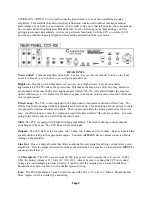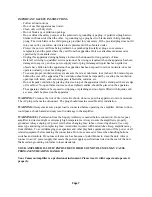
Page
2
CONGRATULATIONS!
You've just become the proud owner of one of the world's finest guitar
amplifiers. This amplifier has been designed, refined and constructed to deliver maximum musical
performance of any style, in any situation. And in order to live up to that tall promise, the controls must
be very powerful and sophisticated. But don't fear! Just by following our sample settings, you'll be
getting great sounds immediately. And as you gain more familiarity with the CCV’s controls, it will
provide you with much greater depth and more lasting satisfaction from your music.
REAR PANEL
Power Switch
: Turns the amplifier on and off.
Caution: Ensure that the Standby Switch on the front
panel is in Standby position prior to powering the amplifier on
.
High/Low:
Flip the switch either down (low power) or up (high power). Low power applies
approximately 425-450 volts to the power tubes. This makes the amp have a little bit of sag and more
pronounced bottom end. High power applies approximately 525-550 volts and will make the amp feel
tighter with less give. It is normal for the amp to appear to be louder in low power since the bottom end
is more pronounced.
Effects Loop
: The CCV comes equipped with a high quality, transparent solid state effects loop. The
effects loop is also equipped with an adjustable send level knob. This knob adjusts the send level to help
compensate for decreased/increased signals. The loop is located after the preamp and before the power
amp. An effects loop is a must if you plan on using “time based effects” like chorus or delay. Use send
going to the effects unit, and return from the effects unit.
Midi
: The CCV is equipped with midi switching capabilities. The midi switching controls channel
switching and the boost. The CCV has an 8 pin midi input.
Outputs:
The CCV has 3 sets of outputs, one 16 ohm, two 8 ohms and two 4 ohms. Be sure to match the
speaker cabinet rating to the appropriate output. You must
ALWAYS
have a cabinet connected before
turning on the amplifier.
Line Out
: This is a simple feature that offers an adjustable-level signal for driving external slave power
amplifiers. Here the signal is derived from the speaker terminal, so a speaker (or load resistor)
MUST
be
connected at all times!
A.C Receptacle
: The CCV uses a removable IEC type power cord to supply the A.C. power. In The
USA, the proper voltage is 117 volts A.C (110-120). Always be sure to connect the CCV to its rated
voltage to avoid damaging internal circuitry. Located inside the receptacle is a 4 amp Slo-Blo fuse.
Should the fuse blow, replace it with a similar type and rating.
Fuse:
The FUSE should be a 2 amp Slo-Blo for use with 100 or 117 volts A.C. Mains. Should the fuse
blow, replace it with a similar type and rating.








